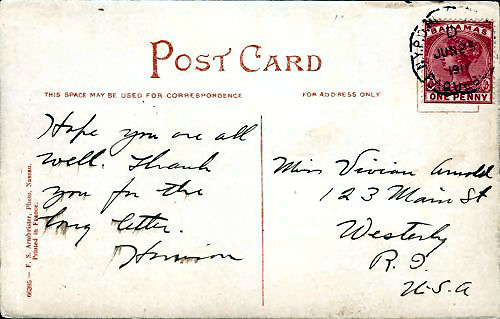![]()
Home Page
Postal History Introduction
Stampless
Covers
1846
to 1900 Issues
1901-1950
Issues
1951-2003
Issues
Cancels
&
Miscellaneous
Postal
Stationery
Post
Cards
Air
Mail
First
Day &
Event Covers
Parcel Post/Special Delivery
Registered & Official Mail
Commercial & Advertising
Revenue & Postage Due
Wildlife & Game Issues
Complete List of RI Issue
June 25, 1911 NY Post Office
Paquebot
Bahamas Postcard - Nassau Courthouse/Post Office
(Scroll Down for Background Information & History)
Vivian Arnold was born in Westerly, Rhode Island on October 22, 1893. She died in October 1981. The Bahamas were the first landfall for Christopher Columbus, who landed on San Salvador in the Eastern Bahamas in 1492. The Bahamas were first settled by the Lucayan Indians a branch of the Arawak people who fled to these islands to get away from the fierce Carib Indians, who had invaded their home islands. Slavery, and disease had wiped out the entire tribe less than 25 years later. Eleuthera was the first island to be settled by the English in 1648. The Islands were a popular hideout for pirates during these early times and for a time Nassau was homeport to Edward Teach, (Blackbeard). In 1776 there was a large influx of British loyalist (Tories) to the Islands who bought their slaves with them and proceeded to grow cotton, tobacco and other crops. During the American Civil War, the Islands provided an exchange point for Confederate blockade runners to sell their goods and buy supplies from the British. When Prohibition was enacted in the U. S., the Islands once again became a haven for smugglers and a huge flow of Scotch Whiskey entered the states from this area. After the 1920s, the tourism industry became the mainstay of the Islands economy. The Bahamas became a Commonwealth in 1969 and an independent Nation on July 10, 1973. SEE: Paquebot Markings for further information concerning Paquebot Mail. |
![]()
RI Historical
Society
The Post Offices
Home Page
RI Tercentenary Issue History
RI Philatelic Society
Recently Added Pages
Philatelic Primer
Rhode Island Around the World
Rhode Island
Town Postmarks
Other Websites of Interest
Return to RI
International
Mail Thumbnail Page Part 1
OR
Return to Paquebot,
Packet
Boat, Seapost Thumbnails

